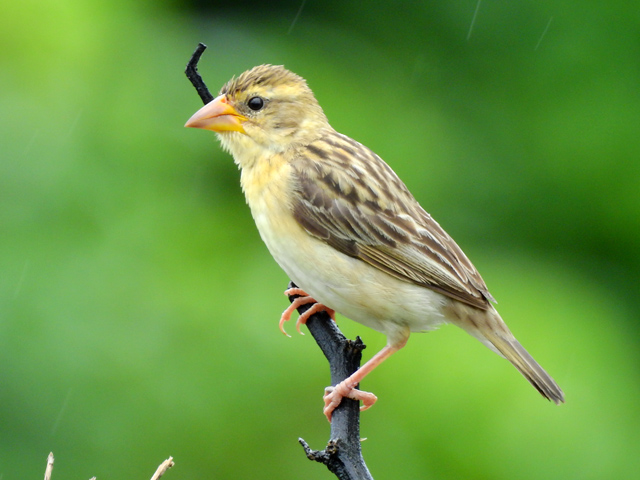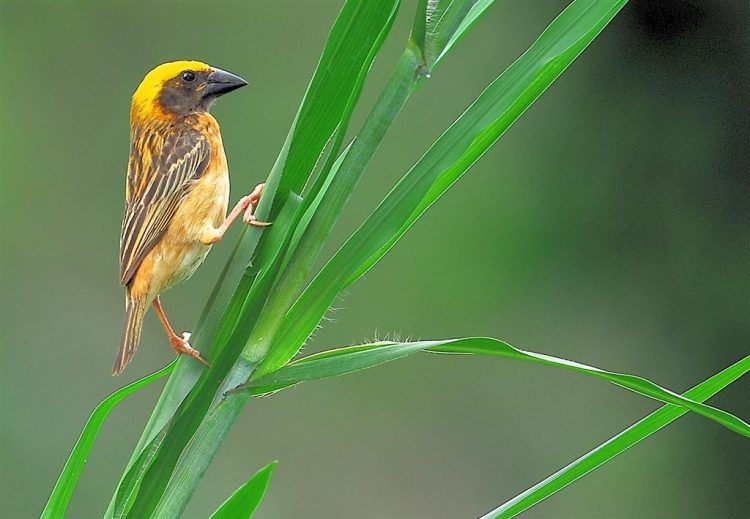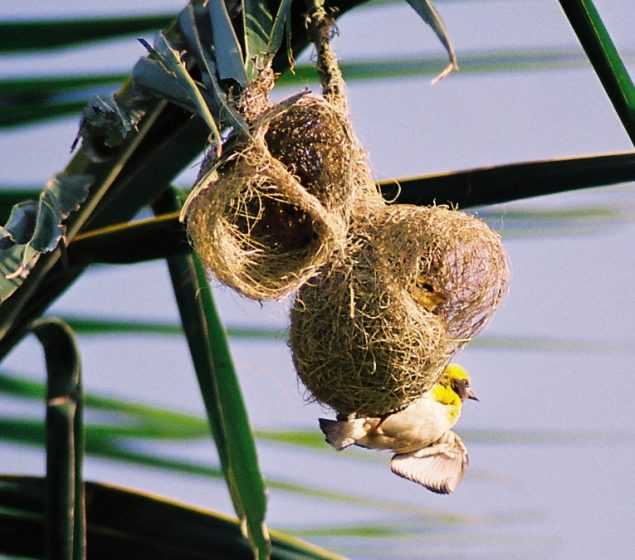The variety that builds the more elaborate nest is the Baya (Ploceusp. philippinus). The Baya Weaver Bird is also found all over the subcontinent, Java, and Sumatra. The male resembles the female during the "off" season but after the spring and autumn molts, he assumes canary-colored crown and other yellow patches, well distributed over most of his otherwise brown and white body.
Baya Weaver Bird decoration loses when their is no nesting to occupy his attention. The bird’s flocks are found in scrub, grasslands, cultivated areas, and secondary growth. Also, these birds are best identified for hanging retort-shaped nests woven from leaves. The Baya Weavers love to live and build in colonies and usually select for the purpose of the neighborhood of a convenient tank or of a terraced rice field.
Being graminivorous animals they find that paddy fields furnish valuable granaries for a food supply. The nests found in the Northern Province of Sri Lanka almost habitually hang from the north and east exposures of the trees. In which they built and thus are least endangered by the battering winds of the Southwest Monsoon.
Though, the much has been written about the amazing nests of Ploceus. They're are several interesting points connected with there construction that have escaped most observers or that do not appear to have impressed writers sufficiently and propose with the aid of a series of photographs taken in situ to point out some of these curious happenings.
While the Tailor Bird does her best to conceal her nest (in which she succeeds an admirably) the Weavers build there homes quite in the open where they can be seen of all men. They're are a number of nests in a colony that had settled in a large tree growing about the center of a Sri Lanka. They came and went as if no human being were near them.
Wherever placed the main objects sought shelter from bad weather and safety from enemies. These provisions are reflected in the suspension of the nests on the sheltered side of a tree on branches detached from other limbs and by the peculiar form and swinging character of the nesting houses.
They're is, however, one precaution always taken the nest hangs free in air and swings from the tree on which it is built in such fashion that it cannot be approached from below or from neighboring branches and when that end is accomplished the birds may suspend there nests from quite low points, often not more then fifteen feet from the ground.
The terminals of palm fronds and other branchlets about twenty feet from the earth, or surface of a pond, our favorite sites. According to some writers, the Weavers, instead of building a new nest once or twice a year, may repair an old one, the chief evidence of which is the color contrast between the nest and the Old grass employed in the process.
Indeed a tree colony of several dozen nests may exhibit at the same time a collection of structures that vary in age from old specimens battered by months of wind and rain to new and fresh nests on which the builders are still working. In some of the latter from one to four white eggs may be hatching; from others issue little chattering cries that betray the presence of hungry fledglings.
The shape of the Ploceine nest has been likened to various objects retorts, inverted bottles, flasks, etc. But to Newton's similitude comes nearest to it.' He compares it to a stocking hung up by the toe, the heel enlarged to receive the eggs, as entrance and exit are made through the leg. The material out of which the nests are made is mostly pliant grass stems and other tough fibers, especially strips of palm fronds.
The bird's strip from the leaves of palms, plantains, agaves, and other stringy plants fine but very strong threads for the weaving process. The bird collects them in this manner. Usually, bird bites a small piece from the base of the palm, sisal, hemp, or another fibrous plant, repeats the incision towards jerks his head away from the leaf, thus tearing off a fine cord, perhaps a line in breadth that corresponding length to the distance between the two incisions.
It examined with a lens this weaving material from many nests and believes the description to be most accurate. Moreover, watched the birds repairing the exterior and arranging the material of there nests and have often seen them tugging at a length of the fiber, part of which has already been woven into the nest. Also seen them flying in the air with the free end of a strand in there bills, so that it might be drawn taut and smooth before inserting it beneath other fibers for the support of the nest wall.
As a preliminary to the construction of the nest proper, the birds wrap a considerable amount of fibrous material around a chosen limb or frond. Often it is as much as three or four feet from the top of the pendant next to the further end of this anchorage, thus securing a firm hold upon the tree. The small strips are not only wound around the branch but are plaited together so securely that it is impossible with an ordinary effort to separate them.
The plaiting is than continuous downwards from the branch to form a stout aerial stalk from 3 or 4 inches to a foot in length. The end of which is evidently expanded into the globular structure of the nest proper. The long diameter of this bulb is from 5 to 6 inches; it's short diameter about four.
Having shaped this upper chamber and located the future egg chain bet, the birds next build a strong, compactly woven transverse band or bridge that divides the lower part of the space into two unequal chambers. In every large colony are found what looks like unfinished nests that do not in the building get farther then this perch or roost stage, looking, like an inverted basket with a handle.
So far as they go, these structures seem strong and well-finished, giving rise to many speculations as to there status. Are they made in an excess of home-building zeal by the male bird upon who's feet and beak time hangs heavily? Or, are they shelters to which he may retreat and rest secure from the torrential Monsoon?
The main argument favoring this hypothesis is of course. The finished appearance in various cases of the canopy itself, it's thick, smoothly plaited walls. Hence, the rounded edges of the perch, and absence of any attempt to completing the base of the globular chambers or the entrances pout. It is suggested that the canopy is a nest deserted after partial construction on account of some fault in it an egg chamber too small, a neck not strong enough, etc.
Whether the canopy is deliberately planned as a shelter for one or both birds, or whether it is only a partially built and deserted nest, their can be no doubt that the non-incubating male has been seen occupying the structure and using it as a perching convenience and their is no doubt that, whatever the original purpose of these structures, the canopy does make an admirable refuge from wind, rain and hot sun.
The illustrations show more plainly then any description of the forms and the relative size of the completed nests and so-called canopies both before and after removal from the tree-colony. One colony, placed in a Halamba tree, furnished four canopies, as well as two full-lengths and one short nest. On the ground beneath the tree were picked up evidently detached by the wind--five full length and two short-tube nests.
In another tree, it can be found seven canopies and five nests. Three egg chambers held a single egg and two had two eggs each. All the canopies had, on or near there margins. Farther the small lumps of dried mud, about which something farther will be said; on the other hand, very few nests showed these deposits. The lowest structure was 12 feet from the ground. The average was 16 feet and the highest about 25 feet.
A small but for many reasons interesting colony had nested in a Damba tree. It numbered two canopies one definitely unfinished nest, one long (with it's entrance tube fifteen inches) and two completed but shorter nests. The long nest contained fledgling’s inches.
The length of the shortest tube was 3 inches; the others varied from 6 to 15 inches. The circumference of the smallest nest was 14 inches; of the largest 18.50 inches. The longest nest measured, overall, 37 inches; the shortest 17 inches.
As for the four canopies, the total length of the shortest was 12.75 inches; of the longest, 16.50 inches. The height of the chamber varied from 4 to 6.50 inches. Thus the width of the bridge or perch is one half to one inch. The diameters are the two entrances from 2.25 by 3.75 inches to 3.50 by 2.50 Inches.
The circumference of the largest canopy was 20 inches; of the smallest 15 inches. Hence one sees that the nests and canopies vary noticeably in size and capacity. The smaller of the two cavities divided by the transverse roost or perch is the one continued into the long tube-like entrance. As soon as when the egg-chambers finished. Female bird confines her concentration to the completion of the interior of the nest and leaves the work on it's exterior to the male.
They seem to work together, although the male gathers most of the building material which he pushes through the walls. It is than woven back and forth as long as possible that is until thick, tough, solid, basket-like walls are the result. The male bird now completes the entrance-spout strengthens the walls of the upper nest and, in some instances begins a second nest like the structure already mentioned. During the nest building, both birds enjoy them thoroughly.
Also, the male bird often sings a little song when he joins with his mate in weaving the nest material. Even after the eggs have been laid and the female has commenced incubating the male continues to lengthen the entrance tube and to put what he regards as the finishing touches on his house.
Also, it is often seen him diligently pushing fibers into place and pulling them back and forth on the surface of the nest to the accompaniment of a sweet little warble. I have never found a smooth firm margin on the end of any entrance tube; it is always frayed, thin and loosely woven, presenting a decidedly unfinished appearance.
The length of the cylindrical entrance tube--generally two inches in diameter varies greatly, as will be seen in the illustrations. Indeed the longest one I ever saw was in the private aviary of Mr. Shore-Bailey of Westbury, England, who has been very successful in breeding these birds in captivity. One of his nests has the entrance tube more then thirty inches long.
The length, strength, and thickness of the various external components of the Weaver Bird's nest depend largely upon the building capacity of the male bird. As with male humanity, this varies greatly. Long after the female begins to sit he may continue his task of nest building. If he is possessed of the building urge he strengthens the attachment of the structure to the tree above, adding more strands of fiber to and lengthening the rope that is already wound about the branch above.
This suspension cord is also increased in sustaining power by short fibers of palm or agave, plaited with strands already in position; and the walls of the nest chambers themselves are consolidated by similar material worked into there thickness. Meantime the tubular entrance is extended and the upper two-thirds of it farther strengthened.
When the young birds are first hatched they are probably fed by the parents with food brought in by way of the long tube but in some instances, at least, opening remade by the male bird from the outside directly into the egg chamber and the fledglings re-fed through these holes. One of the most fascinating habits of the Baya is the manner in which he enters and leaves the nest. I have watched the process many times and have always gazed in wonderment.
Even the so-called Chimney Swift entering his home may learn something from a bird that, apparently without agitating the shaky structure of his domicile flies up to the narrow chimney-like structure and out again without hesitation. I have seen the male in the midst of a job of repairing the roof suddenly take it into his head to visit his brooding wife. Flying or tumbling down the side of the nest he spread his wings just in time to stop his fall a foot or two below the entrance. Apparently, without effort, he turned in midair and shot, like lightning, into the cylinder above him.
Some do not believe any other bird could have done it. Legge, who has wings at the moment of entering the tube and runs up it to the egg chamber. Be that as it may, Ploceusis secure in his home, for he is certainly the only animal that can fly, crawl, run, or creep up the smooth, fragile, tube that leads to the interior of his nest. The completed nest is a firm springy contrivance and so well woven that when thoroughly dried it is used by the natives for filling mattresses.
Sometimes during nest building, the birds bring in small lumps of wet clay which they stick to a variety of parts of the interior of the nest and it's walls. So, it found curious deposits in varying quantities in almost all the nests examined. One had about a tablespoonful of plastic mud deposited on three diverse localities, including one small patch in the egg chamber. On the other hand, a few had no mud deposits and others had very little. Just what these clay deposits mean is by no means clear.
Indeed none of the numerous explanations is satisfactory, especially reject the generally accepted theory that the mud is employed to balance the nest in the wind, and to prevent it's being blown about while tile birds are entering and leaving it; nor can I adopt Layard's guess that tile birds use the clay as a sort of whetstone on which to sharpen there bills. In the first place, half a tablespoon of dried mud plastered midway of a large and longs winging nest can have no influence whatever upon it's equilibrium in even a mild breeze.
Than again, many nests have no mud in there structure at all. Of course, the natives, as usual, have there interpretation of the phenomenon--the bird uses the clay as a candlestick on which is stuck glowworms to lighten the darkness of the nest! Perhaps I may add another and to my mind more plausible theory-•-the habit is the survival in Ploceus of some ancestor who built his nest partly or entirely of clay.
The black clay deposits in Baya's nest, than serve no useful purpose at all. They are just vestigial remains of a household economy, as the sleeve buttons on one's coat! One is reminded of stone what similar example in the habits of birds completely unrelated to the Weaver. But this genus is in an evolutionary sense flanked on the one hand by genera (Micropus, Taehornisw) hose nest material is partly mucus and partly other material, and on the other by genera who's nests have little or no mucoid matter in there makeup.
However that may be, our Weaver Bird is a highly intelligent animal, and whether one attributes his remarkable house-building to instinct, to reason, or, as is most probable, to a combination of these faculties, he makes a very attractive captive and an engaging presence in an aviary large enough to afford him plenty of room in which to build and breed.
He is, though, impatient of avian relatives, and is very likely to quarrel with other birds placed with him in the same flight. T. B. Fletcher (Birds of an Indian Garden, 1924) tells us that Among the natives of Punjab a popular rhyme contrasts the helpless monkey with the resourceful; house-building Weaver.
In that, the former cannot protect himself from the weather in spite of his human hands and feet. This verse is quoted for the benefit of small boys and girls who object to learn, just as the busy bee is held up for infantile admiration of Western lands." Read More - Red Breasted Robin – Friendly Garden Visitors
[caption id="attachment_28440" align="aligncenter" width="640"] Female P. p. philippinus
Female P. p. philippinus Male burmanicus showing bright yellow crown
Male burmanicus showing bright yellow crown Male P. p. philippinus (India)
Male P. p. philippinus (India) Male philippinus displaying at the nest
Male philippinus displaying at the nest Nests hanging from palm (Phoenix sp.) fronds
Nests hanging from palm (Phoenix sp.) fronds White-rumped munia using an abandoned nest
White-rumped munia using an abandoned nest


































